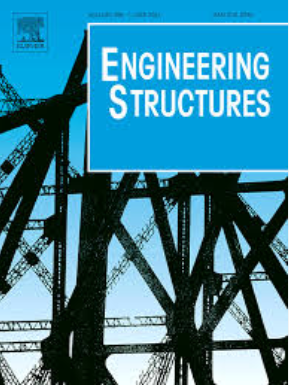Bio-inspired variant honeycomb structures via 4D printing: Revolutionizing the realm of energy absorption
IF 6.4
1区 工程技术
Q1 ENGINEERING, CIVIL
引用次数: 0
Abstract
Conventional hexagonal honeycomb structures face limitations in post-fabrication adaptability and energy absorption tunability. In this study, we propose a bionic variant honeycomb (BVH) structure based on 4D printing, which achieves shape-property synergistic modulation by incorporating shape memory polymers (SMP). Based on the vertex reconfiguration strategy, concave, quadrilateral-like and flattened hexagonal honeycomb cells are designed, and the energy dissipation paths are optimized through combinatorial and hierarchical configurations. Poly(lactic acid) (PLA)-based honeycomb structures are prepared by fused deposition molding technique, which is combined with thermo-mechanical programming to achieve the programming of temporary shapes and reach the intelligent regulation of energy absorption capacity, e.g., the specific energy absorption is reduced by 55.7 % at 30 % pre-strain. Experiments and finite element simulations show that the hierarchical configuration significantly improves the energy absorption efficiency. This study innovatively combines 4D printing with biomimetic design to give the honeycomb structure the adaptive ability to actively respond to external stimuli after fabrication, providing a new paradigm for the development of smart energy-absorbing metamaterials. This research will show a broad application prospect in the fields of automobile collision protection and aerospace.
通过4D打印的仿生蜂窝结构:革命性的能量吸收领域
传统的六边形蜂窝结构在加工后适应性和能量吸收可调性方面存在局限性。在这项研究中,我们提出了一种基于4D打印的仿生变型蜂窝(BVH)结构,该结构通过加入形状记忆聚合物(SMP)来实现形状-性能协同调制。基于顶点重构策略,设计了凹形、四边形和扁平六边形蜂窝单元,并通过组合配置和分层配置优化了能量耗散路径。采用熔融沉积成型技术制备聚乳酸(PLA)基蜂窝结构,并结合热-机械编程,实现临时形状的编程,达到吸能能力的智能调节,在30 %的预应变下,比能吸收降低55.7% %。实验和有限元仿真结果表明,分层结构显著提高了吸能效率。本研究创新性地将4D打印与仿生设计相结合,使蜂窝结构在制造后具有对外界刺激主动响应的自适应能力,为智能吸能超材料的发展提供了新的范例。该研究在汽车碰撞防护和航空航天领域具有广阔的应用前景。
本文章由计算机程序翻译,如有差异,请以英文原文为准。
求助全文
约1分钟内获得全文
求助全文
来源期刊

Engineering Structures
工程技术-工程:土木
CiteScore
10.20
自引率
14.50%
发文量
1385
审稿时长
67 days
期刊介绍:
Engineering Structures provides a forum for a broad blend of scientific and technical papers to reflect the evolving needs of the structural engineering and structural mechanics communities. Particularly welcome are contributions dealing with applications of structural engineering and mechanics principles in all areas of technology. The journal aspires to a broad and integrated coverage of the effects of dynamic loadings and of the modelling techniques whereby the structural response to these loadings may be computed.
The scope of Engineering Structures encompasses, but is not restricted to, the following areas: infrastructure engineering; earthquake engineering; structure-fluid-soil interaction; wind engineering; fire engineering; blast engineering; structural reliability/stability; life assessment/integrity; structural health monitoring; multi-hazard engineering; structural dynamics; optimization; expert systems; experimental modelling; performance-based design; multiscale analysis; value engineering.
Topics of interest include: tall buildings; innovative structures; environmentally responsive structures; bridges; stadiums; commercial and public buildings; transmission towers; television and telecommunication masts; foldable structures; cooling towers; plates and shells; suspension structures; protective structures; smart structures; nuclear reactors; dams; pressure vessels; pipelines; tunnels.
Engineering Structures also publishes review articles, short communications and discussions, book reviews, and a diary on international events related to any aspect of structural engineering.
 求助内容:
求助内容: 应助结果提醒方式:
应助结果提醒方式:


